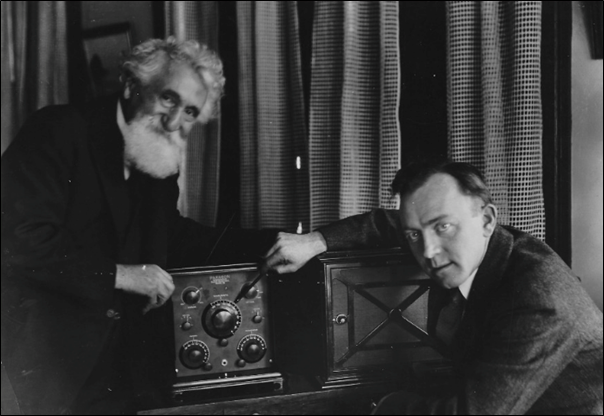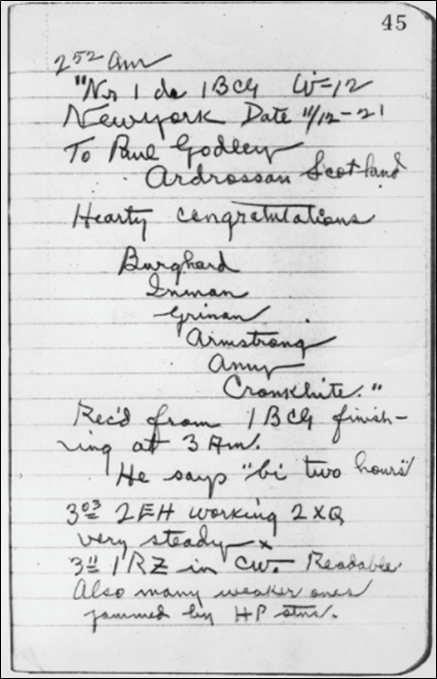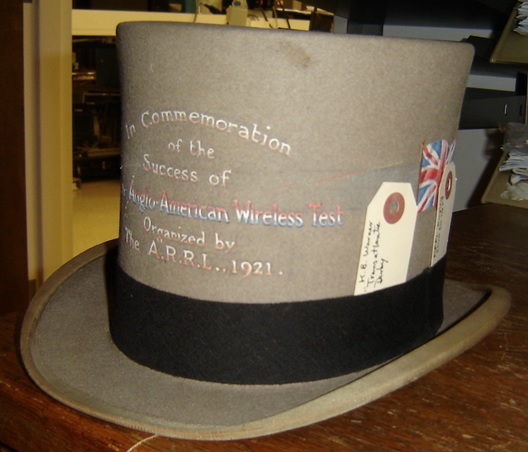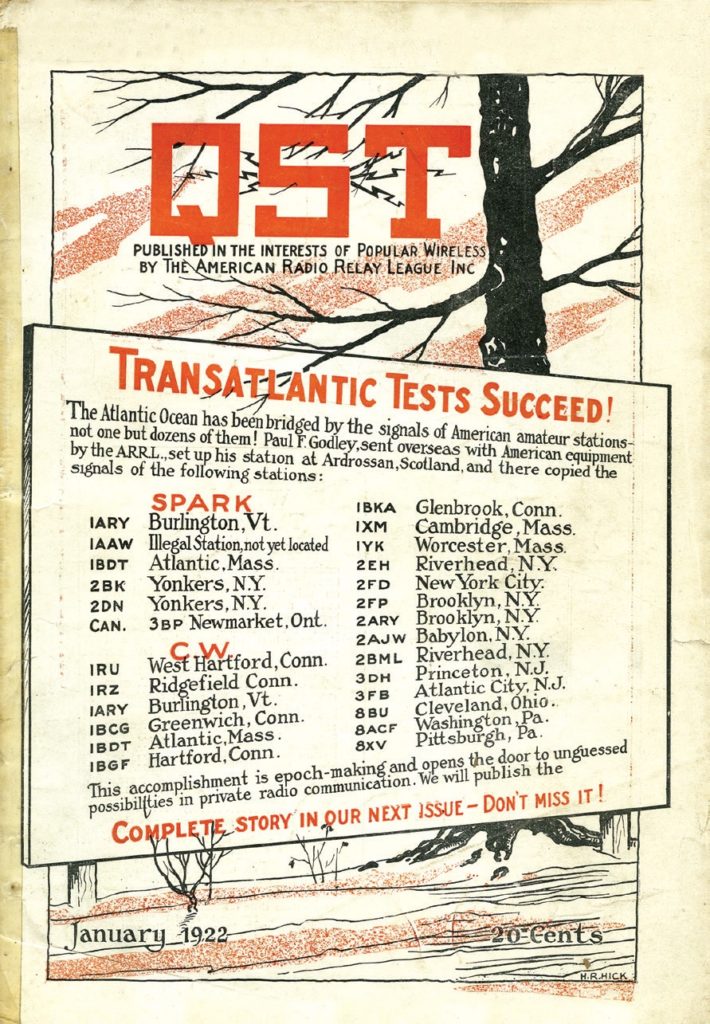Transatlantic Tests 2 – Part 2
Paul Godley, the Hard Boiled Ham, wins the bet for the ARRL
As the Second Tests start, Paul Godley has his radios commissioned ready for a series of long nights listening on the radio. Confidence was high as on the day before the tests were scheduled to start, he was hearing signals around 200 metres which he attributed to US amateurs.
I was greatly elated, and felt very confident that we would soon be hearing many others! Chill winds and cold rains, wet clothes, and the discouraging vision of long vigils under most trying circumstances were forgotten amidst the overwhelming joy of the moment – a joy which I was struggling to hold within! I suggested hot coffee at once, and Pearson volunteered to warm it on our stove. He had pot and bottle in his hands when I called sharply to him to resume watch! Our welcome American friend was at it again with a short call for an eighth district station! His signal had doubled in strength, and he was booming through the heavy static and signed off clearly 1AAW, at 1:42 am!
No more US stations were heard that first night and 1AAW was unable to be identified in the US apart from maybe as a pirate operator in the Boston area. 8 Dec when the tests began, proved somewhat disappointing for Godley with no US signals heard. Godley wired Coursey, the Wireless Society of London coordinator ‘Cooler, clear; moderate atmospherics, no signals.’

Paul Godley demonstrating the Paragon receiver to Hudson Maxim, Hiram Percy Maxim’s uncle – copyright Bruce Littlefield, used with their kind permission
Godley’s log for 9 December recounts the first definite US amateur signals being heard.
At 12:50, after listening some time for free-for-all sparks, we swing over to CW and it is indeed a thrill we get when 1BCG (the RCA station in Connecticut) is picked on 230 to 235 meters. A harmonic from Clifden is jamming but after some adjustment this is partially nullified. Signals from 1BCG very steady and reliable. Remarkable performance and I wonder what power he is using. Lose him many times in an effort to ‘feel out’ the Beverage wire, but get him much better after adjustments terminated at 1:33. He is calling ‘PF test’ and signing. Sweetest song I have ever heard.
At 1:59 am he calls 2BGM and says ‘Phone us now’, then shuts off. Measures between 230 and 235 meters on little General Radio meter.
Pearson and I relax, laugh with glee, and start looking for something to eat and drink.
Continue through night to hunt for more, but without avail.
Shut down 6 am but start up again after talking it over, to copy MUU. MUU sends ‘Godley’s message’. It comes home to me that ours is a history making set of tests – that American amateur radio has the world by the ears.
Godley wished he had a transmitter with which to reply.
I would give a year of my life for a 1kW tube transmitter, a nice, upstanding aerial and a British Post Office licence to operate it on 200 meters. To be forced to listen to a Yankee ham and only listen is a hard blow.
At this point in proceedings Godley’s cause was slightly set back in that he determined correctly that rather than just hearing the US amateurs, what was required was hearing a specific message addressed to himself from the US – half a QSO if you like.
I then decided that no one thing would forever redound to the credit of amateur radio more than the transmission and successful reception of a complete message and I wired Armstrong (who was one of the operators at the RCA station 1BCG) direct as follows: “Signals wonderful send messages starting one Greenwich” and went to bed with a singing heart and thoughts of the coming night when we would be copying (perhaps) messages.
Godley used commercial telegraph stations to send messages back to the US. Unfortunately, in this case his request became somewhat garbled and was misinterpreted.
Some British telegrapher against whom I shall carry a grudge to my grave had “bulled” my cable, for it reached Armstrong reading “SEND MGES”, and he did! He sent “MGES” over, and over, and over until I was sick! He kept it up the entire night, regardless of schedule, and no earthly way of stopping him!
Godley’s log for December 10th-11th reads:
Get set at about 12:50, and at a few minutes past one, pick up 1BCG, sending ‘Mges’ over and over. Signal very strong and steady. Static very strong too, and have considerable difficulty to get signal-to-static ratio up. He fades more than last night. At 1:14 am he says: ‘three minutes’. I expect him to start sending messages, so anchor on him, making adjustments for improvement from time to time, and am very thankful for such a fine signal to work on.
1:16 – There, but unreadable.
1:17 – There, but unreadable.
1:18 – Faded out.
1:20 – Returned a bit. Static getting heavier and adjust to reduce. Now have him saying “Mges” over and over.
Godley eventually abandoned listening to 1BCG and spent the rest of the early morning session logging a good number of US amateur transmissions, some spark and some CW. He sent confirmation by wire to Coursey for the Wireless Society of London and to the ARRL, also asking the operators at 1BCG to send news.
1BCG is some station, and Pearson and I both agree 1BCG was commercial signal 3 to 6 am. Some of the boys will be very much surprised too, because have heard some who never dreamed of getting over.
This time, the message to the ARRL guys gets through, without being confused, and at 2:52 am on 12 December in Scotland, Godley receives the very first personal message transmitted over the Atlantic from amateur to amateur.
Monday, December 12th:
2:50 – 2EH calling 8AFD very steady. 1BCG in with messages.
2:52 – He starts: “Nr 1 de 1BCG words 12, New York. Date December 11, 1921, to Paul Godley, Ardrossan, Scotland. Hearty Congratulations. (Signed) Burghard, Inman, Grinan, Armstrong, Amy, Cronkhite.” Received from 1BCG finishing at 3 am. He says “Bi two hours”. (Last heard of him.)
“Wired Coursey: ‘Burnham owes Warner new hat.’ Warm rains, calm, decreased atmospherics. 1BCG calling me ending two Greenwich. Undamped two thirty, strong, steady. Congratulations.'”[1]

Key page from Godley’s logbook – copyright Bruce Littlefield, used with their kind permission
There was massive excitement in the USA at the success of the Tests, as described in QST, January 1922.
Transatlantic Tests Successful
Oh, Mr. Printer, how many exclamation points have you got?
Trot ’em all out, as we’re going to need them badly, because WE GOT ACROSS!!!!!!
As we prepare the copy for this issue of QST our Transatlantic Tests are in progress and we have the highly gratifying news from Paul F Godley, our special listener in Scotland, that the ARRL has spanned the Atlantic! For the first time in history the signals of United States and Canadian amateur stations have been heard across the ocean on schedule.
Mr. Philip R. Coursey, in charge of arrangements in Great Britain, radioed us on Dec. 13th as follows:
“Many your stations heard by British amateurs. Details later.”[2]
Wireless World, 29 April 1922, describes the outcomes and the winning of the bet by the ARRL’s Warner.
An Echo of the Transatlantic Tests
In the issue of The Wireless World for October 29th, 1921, in outlining the conditions of entry for the recently conducted Transatlantic Tests, we quoted a criticism of the capabilities of the British amateurs to receive the signals which had appeared in the American journal, QST. The quotation was as follows:
“Such reception is a new field for British experimenters, and they hardly can be expected to show the same performance as an American dyed-in-the wool ham who has learned how to get amateur DX only after years of patient struggle. We have tested most of the circuits used by the Britishers, and find them one and all decidedly inferior to our standard American regenerative circuit using variometer tuning in secondary and tertiary circuits. We would bet our new spring hat that if a good US amateur with such a set and an Armstrong Super could be sent to England, reception of US amateurs would straightway become commonplace.”
We give here an illustration of the hat prepared for Mr. Warner, which has just been dispatched to the States by Mr. Burnham.
The hat is of light grey felt and bears on one side the stars and stripes, and on the other the Union Jack united by wireless flashes encircling the crown. In front can be seen the inscription of dedication. Unfortunately, the photograph cannot reproduce the colours of this work of art, so that a full appreciation of its beauty is not possible.[3]

(Copyright ARRL, used with their kind permission)
The final reckoning showed that Godley had heard eight spark and 18 CW stations and eight English stations had successfully heard eight US stations, all CW – a significant milestone in the journey to amateur radio shortwave international communication. Although it was Godley who received the first personal message, he wasn’t alone in copying US signals.
Godley travelled home to a hero’s welcome, as well he deserved.
The return trip on the Olympic was rather an uneventful one, except for the reception of a radiogram dated Hartford, Conn., requesting information as to date of arrival and also advising me that a reception committee would be on hand at the dock. In due time I found myself emerging from the side of the huge ship, and fell into the arms of press correspondents, photographers and friends.
We have just finished making a real bit of radio history. What we have done means, first of all, that it now lies within our power to communicate frequently with our British cousins, provided we show this will to do so.[1]

(Copyright ARRL, used with their kind permission)
For 2021, our centenary story ends with the 1921 amateur conquest of the Atlantic in one direction – West to East – and ironically, Milton Sleeper’s forecast that “the first experimenter, to transmit across the Atlantic, his name will never be forgotten as long as there are radio experimenters” was incorrect, as it is the name of Paul Godley, the receiver of the first message, that is remembered.
At the completion of the second tests in December 1921, the scene was set for the third Transatlantic Tests in December 1922, when the Wireless Society of London (to be renamed RSGB in November 1922) had to rise to the challenge of transmitting from East to West.
References
[1] Paul F Godley, Official Report of the Second Transatlantic Tests, QST, February 1922, pp. 14-28, 36-40, 46
[2] Transatlantic Tests Successful, QST, January 1922, p. 7
[3] An Echo of the Transatlantic Tests, Wireless World, 29 April 1922, p. 150
Other pages in this section










